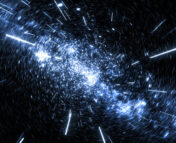Title: Measurement of the Cosmic Microwave Background Spectrum by the COBE FIRAS Instrument
Authors: J. C. Mather, E. S. Cheng, D. A. Cottingham, R. E. Eplee Jr., D. J. Fixsen, T. Hewagama, R. B. Isaacman, K. A. Jensen, S. S. Meyer, P. D. Noerdlinger, S. M. Read, L. P. Rosen, R. A. Shafer, E. L. Wright, C. L. Bennett, N. W. Boggess, M. G. Hauser, T. Kelsall, S. H. Moseley Jr., R. F. Silverberg, G. F. Smoot, R. Weiss, and D. T. Wilkinson
First Author’s Institution: NASA Goddard Space Flight Center, Greenbelt, Maryland, USA
Status: published in ApJ [open access]
Back in the mid-20th century, there were two competing theories about the origin of the Universe. Scientists, including Edwin Hubble and Georges Lemaître, had already established that space was expanding. Some argued that if you run this expansion back in time, it implies a beginning when everything must have been compressed into a hot, dense singularity, exploding outward from that point in a “Big Bang”. Other astronomers, however, were uncomfortable with the idea that the Universe even had an origin at all. These scientists, most notably Fred Hoyle, argued instead for a cosmology in which the Universe had always existed and had always been expanding, with new galaxies springing up periodically to fill in the gaps. This picture of our Universe is referred to as the Steady State Theory.
These two theories predict fundamentally different things about the background temperature of the Universe. If matter in the Universe does not originate from a single point, as in the Steady State picture, then we would expect the background radiation to be chaotic in nature; there would be no reason for different unconnected regions of spacetime to look the same as each other.
However, if everything in the Universe comes from the same initial conditions, then everything should be roughly the same temperature. This can also be expressed as the idea that the Universe should be in thermodynamic equilibrium on large scales, and that if you measure the intensity of background radiation at all frequencies, you should see a blackbody spectrum—the characteristic spectrum of an object in equilibrium, dependent only on the object’s temperature. Thus, a key prediction of the Big Bang theory is that the temperature should be nearly constant over the entire sky, with the differences (called anisotropies) from this constant average temperature being extremely small—around one part in 100,000!
COBE comes to the rescue
Big Bang cosmologists in the 1960s believed that the peak of the Universe’s blackbody spectrum should be in the microwave frequency range, defined as between 300 MHz and 300 GHz. This would be expected from a massive explosion of energy at the Big Bang, the light from which would have been redshifted into the microwave range as it traveled through the expanding universe. So, if the Big Bang theory is true, we should expect to see a constant source of background radiation coming from all directions in the microwave sky: a so-called Cosmic Microwave Background, or CMB.
The detection of this CMB radiation in 1965 by Arno Penzias and Robert Woodrow Wilson, as well as the cosmological interpretation of that detection by Robert Dicke, Jim Peebles, Peter Roll, and David Wilkinson, laid the groundwork for modern cosmology, and was the beginning of the end for the idea that the Universe had no origin. However, Penzias and Wilson’s discovery was not an accurate measurement of the CMB’s temperature or spectrum. No anisotropies had been detected, and there was still debate over whether or not the CMB spectrum was truly a blackbody. The goal of the Cosmic Background Explorer (COBE) satellite, launched by NASA in 1989, was to answer these lingering questions.
COBE was split into three instruments: the Differential Microwave Radiometer (DMR), the Far-InfraRed Absolute Spectrophotometer (FIRAS), and the Diffuse Infrared Background Experiment (DIRBE). DMR measured the CMB anisotropies, while DIRBE mapped infrared radiation from foreground dust.

FIRAS, meanwhile, was designed to measure the CMB spectrum. It scanned the entire sky multiple times in order to minimize errors and measured the temperature over a wide range of frequencies between 30 and nearly 3000 GHz. After eliminating known sources of interference such as cosmic rays, as well as subtracting the effects of light from the Milky Way galaxy and of the Doppler shift caused by the movement of the Earth through space, these scans were then averaged together to create direct measurements of the CMB intensity at various frequencies.
Aftermath

The authors of today’s paper found that the background radiation in our Universe is in fact extremely close to being a perfect blackbody! The final temperature found by FIRAS was reported by Mather et al. (1999) to be 2.725 K, with an uncertainty of just 0.002 K! This is an incredibly high-precision measurement and represents the final nail in the coffin for cosmologies other than the Big Bang. John C. Mather received the Nobel Prize in 2006 for his work as FIRAS’s project lead.

Today, cosmologists use the CMB and its anisotropies to characterize the early history of the Universe, find galaxy clusters in the later Universe, and even look for new physics! Later full-sky measurements taken by the Wilkinson Microwave Anisotropy Probe (WMAP) and the Planck satellite added never-before-seen levels of precision to our ability to study the structure and content of the Universe, and future missions like LiteBIRD will continue to improve our ability to study the CMB even more closely, building on COBE’s groundbreaking data. These experiments still rely upon the CMB temperature established by FIRAS, which remains the definitive result even 23 years after its publication.
Astrobite edited by Archana Aravindan, Huei Sears, and Suchi Narayanan
Featured image credit: NASA/COBE Science Team




